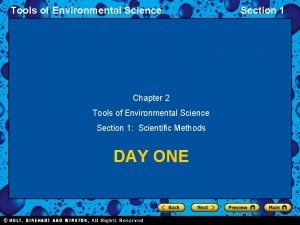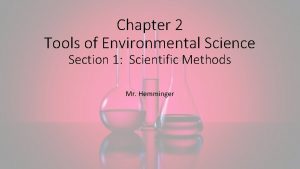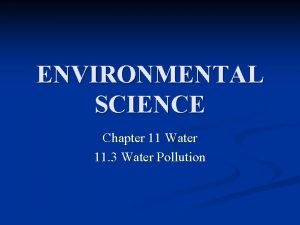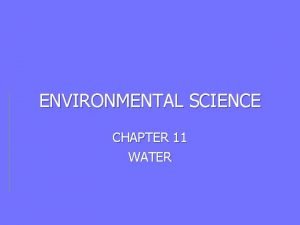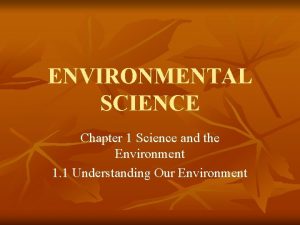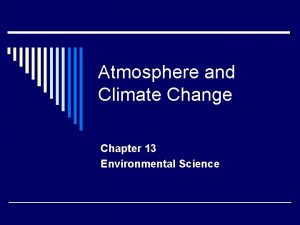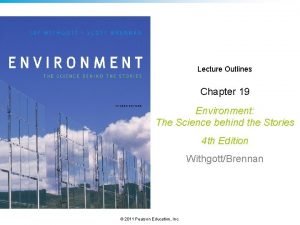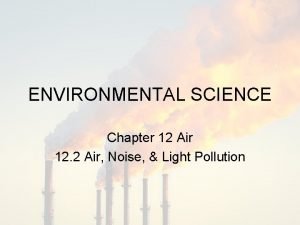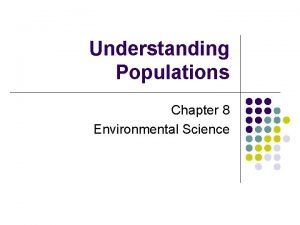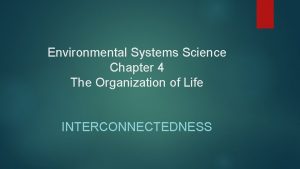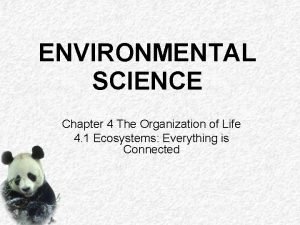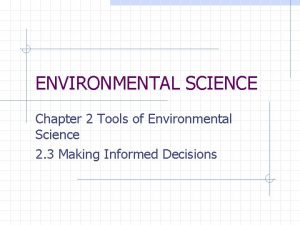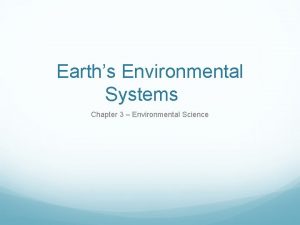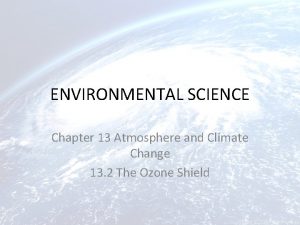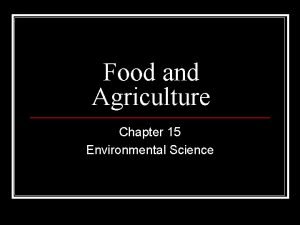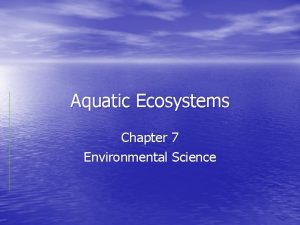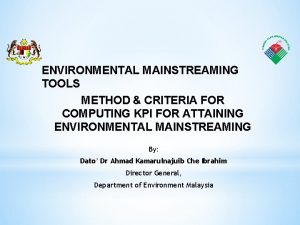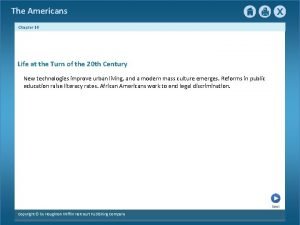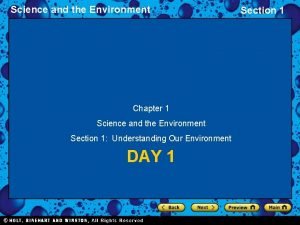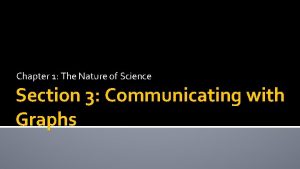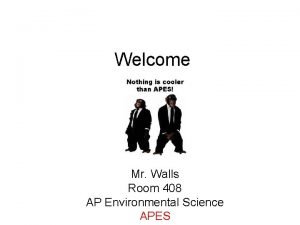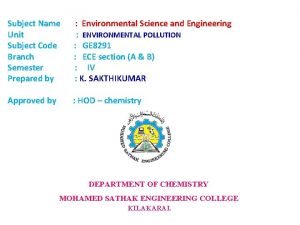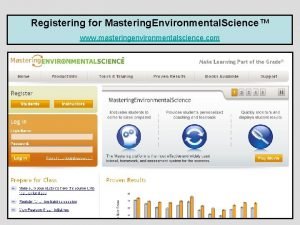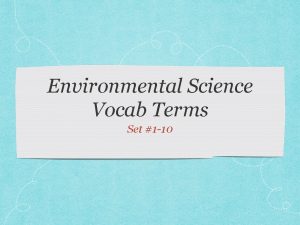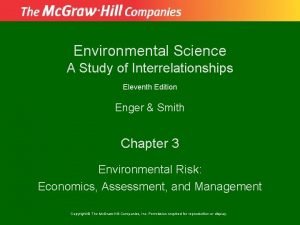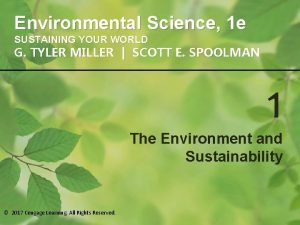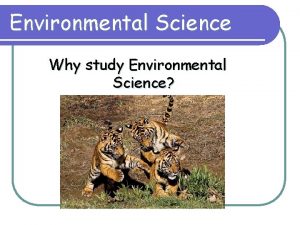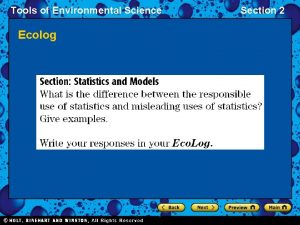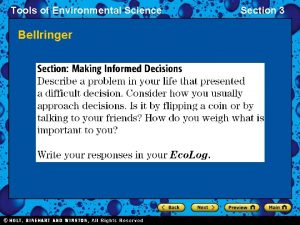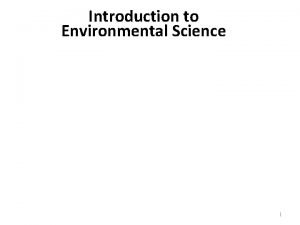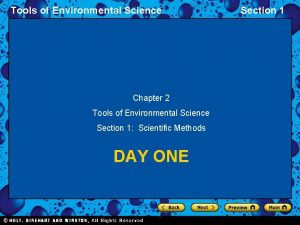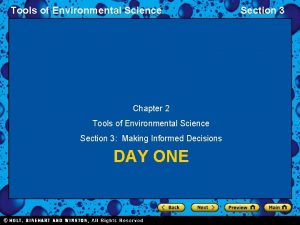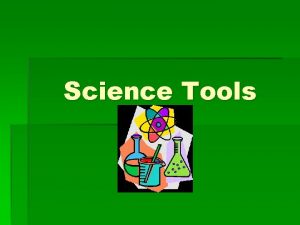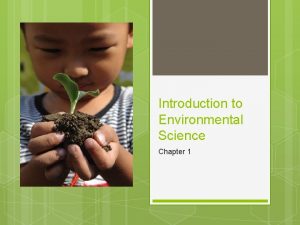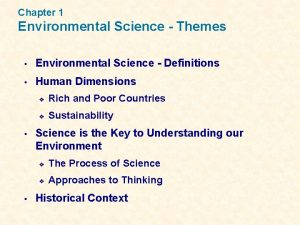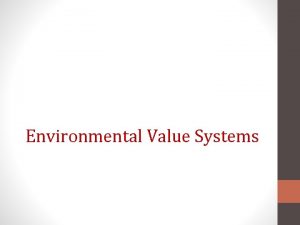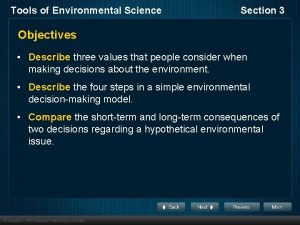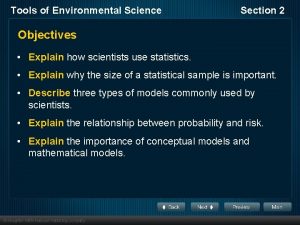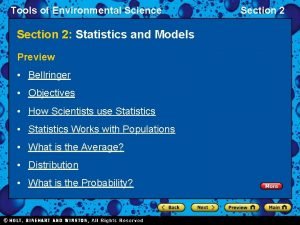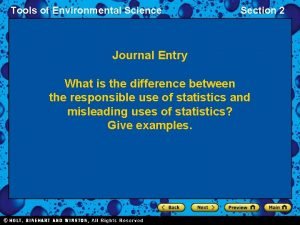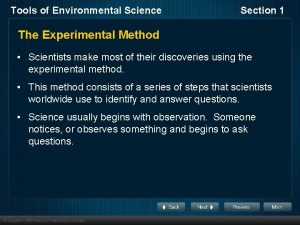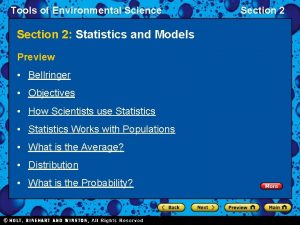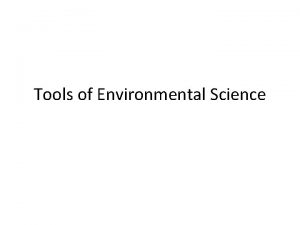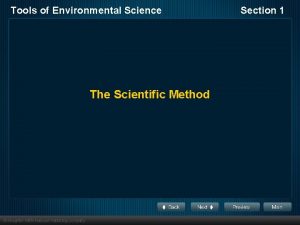Chapter 2 Tools of Environmental Science Section 1






































- Slides: 38

Chapter 2 Tools of Environmental Science Section 1: Scientific Methods Mr. Hemminger

The Experimental Method – Scientific Method • Scientists make most of their discoveries using the experimental method. • This method consists of a series of steps that scientists worldwide use to identify and answer questions. • https: //www. ted. com/talks/stuart_firestein_the_pursuit_of_ignoran ce/discussion? language=en

Observing • Observation is the process of obtaining information by using the senses as well as the information obtained by using the senses. • Observing is the first step of the experimental method. • Observations can take many forms, including descriptions, drawings, photographs, and measurements.

Hypothesizing and Predicting • A hypothesis is a theory or explanation that is based on observations and that can be tested. • Forming a hypothesis is the second step of the experimental method. • A hypothesis is not merely a guess. • A good hypothesis should make logical sense and follow from what you already know about the situation.

Hypothesizing and Predicting • Predictions are statements made in advance that express the results that will be obtained from testing a hypothesis if the hypothesis is supported. • A prediction is used to test a hypothesis.

Hypothesizing and Predicting • It is important that any hypothesis can be disproved. • Every time a hypothesis is disproved, the number of possible explanations for an observation is reduced. • By eliminating possible explanations, a scientist can zero in on the best explanation.

Experimenting • Experiments are procedures that are carried out under controlled conditions to discover, demonstrate, or test a fact, theory, or general truth. • An experiment is performed when questions that arise from observations cannot be answered with additional observations. • Experiments should be designed to pinpoint cause-and-effect relationships.

Experimenting • Good experiments have two essential characteristics: a single variable is tested, and a control is used. • The variable is the factor that changes in an experiment in order to test a hypothesis. • To test for one variable, scientists usually study two groups or situations at one time, with the variable being the only difference between the two groups.

Experimenting • The experimental group is the group in the experiment that is identical to the control group except for one factor and is compared with controls group. • The control group is the group in the experiment that serves as a standard of comparison with another group to which the control group is identical except for one factor.

Organizing and Analyzing Data • Data is any pieces of information acquired through observation or experimentation. • Organizing data into tables and graphic illustrations helps scientists analyze the data and explain the data clearly to others. • Graphs are often used by scientists to display relationships or trends in the data.

Organizing and Analyzing Data • Bar graphs and histograms are useful for comparing the data for several things in one graph.

Organizing and Analyzing Data • Graphing the information makes the trends presented in tables easier to see.

Drawing Conclusions • Scientists determine the results of their experiment by analyzing their data and comparing the outcome of their experiments with their prediction. • Ideally, this comparison provides the scientist with an obvious conclusion.

Drawing Conclusions • However, often the conclusion is not obvious. • In these cases, scientists often use mathematical tools to help them determine whether the differences are meaningful or are just a coincidence.

Repeating Experiments • Scientists often repeat their experiments. • The more often an experiment can be repeated with the same results, in different places and by different people, the more sure scientists become about the reliability of their conclusions. • Scientists look for a large amount of supporting evidence before they accept a hypothesis.

Communicating Results • Scientists publish their results, sometimes in scientific articles, to share what they have learned with other scientists. • Scientific articles include: • the question the scientist explored • the reasons why the question is important • background information • a precise description of how the work was done • the data collected • the scientist’s interpretation of the data.

The Correlation Method • When the use of experiments to answer questions is impossible or unethical, scientists test predictions by examining correlations. • Correlation is the linear dependence between two variables.

Scientific Habits of Mind • Good scientists tend to share several key habits of mind, or ways of approaching and thinking about things. • The first habit of mind is curiosity. Good scientists are endlessly curious which drives them to observe and experiment. • The second habit of mind is skepticism. This means that good scientists do not believe everything that they are told.

Scientific Habits of Mind • The third habit of mind is openness to new ideas. Good scientists keep an open mind to how the world works. • Another habit of mind is intellectual honesty. A good scientist is willing to recognize the results of an experiment even though it may mean that his or her hypothesis was wrong.

Scientific Habits of Mind • Lastly, good scientists share imagination and creativity. • They are not only open to new ideas, but also able to conceive new ideas themselves. • They have the ability to see patterns where others do not or can imagine things that others cannot. • This allows good scientists to expand the boundaries we know.

How Scientists use Statistics • Statistics is the collection and classification of data that are in the form of numbers. • Scientists rely on and use statistics to summarize, characterize, analyze, and compare data. • Statistics is actually a branch of mathematics that provides scientists with important tools for analyzing and understanding their data.

Statistics Works with Populations • Scientists use statistics to describe statistical populations. • A statistical population is a group of similar things that a scientist is interested in learning about.

What is the Average? • Statistical populations are composed of similar individuals, but these individuals often have different characteristics. • A mean is the number obtained by adding up the data for a given characteristic and dividing this sum by the number of individuals. • The mean provides a single numerical measure for a population and allows for easy comparison.

Distribution • Distribution is the relative arrangement of the members of a statistical population, and is usually shown in a graph. • The graphs of many characteristics of populations, such as the heights of people, form bell-shaped curves. • A bell shaped curve indicates a normal distribution where the data is grouped symmetrically around the mean.

Distribution

What is the Probability? • Probability is the likelihood that a possible future event will occur in any given instance of the event. • Probability is usually expressed as a number between 0 and 1 and written as a decimal rather than as a fraction. • However, there must be a large enough sample size in order to obtain accurate results.

Thinking About Risk • Risk is the probability of an unwanted outcome. • People often worry about big oil spills, but as the pie chart shows, there is a much greater risk of oil pollution from everyday sources.

Thinking About Risk

Models • Models are patterns, plans, representations, or descriptions designed to show the structure or workings of an object, system, or concept. • Scientists use several different types of models to help them learn about our environment.

Physical Models • Physical models are three-dimensional models you can touch. • Their most important feature is that they closely resemble the object or system they represent, although they may be larger or smaller. • The most useful models teach scientists something new and help to further other discoveries.

Physical Models • One of the most famous physical models was used to discover the structure of DNA. • The structural model was built based on the size, shape, and bonding qualities of DNA. • The pieces of the model put together helped the scientist figure out the potential structure of DNA. • Discovering the structure led the understanding of DNA replication.

Graphical Models • Maps and charts are the most common examples of graphical models. • Scientists use graphical models to show things such as the position of the stars, the amount of forest cover in a given area, and the depth of the water in a river or along a coast. • Arc GIS – Lab Fridays

Conceptual Models • Conceptual models are verbal or graphical explanations for how a system works or is organized. • A flow-chart diagram is an example of a conceptual model. • A flow-chart uses boxes linked by arrows to illustrate what a system contains, how those contents are organized, and how they affect one another.

Conceptual Model

Conceptual Models • Conceptual models can also be verbal descriptions or even drawings. • For example, one conceptual model of the structure of an atom describes the atom as one large ball being circled by several smaller balls. • This illustrates another point, that a model can be more than one type. • An atomic model made using plastic balls is both a conceptual and physical model.

Mathematical Models • Mathematical models are one or more equations that represent the way system or process works. • Mathematical models are especially useful in cases with many variables, such as the many things that affect the weather.

Mathematical Models • Scientists use mathematical models to create amazing, as well as useful images. • “False color” satellite images are created using mathematical models. • Scientists use the models to relate the amount of energy reflected from objects to the objects’ physical condition.

Things to think about • What is statistics? • Why do we use statistics? • What is the distribution? • What is the average/mean? • What is probability? • What is risk? • List the three types of models AND an example of each type of model.
 Environmental science section 2 review answers
Environmental science section 2 review answers Chapter 2 tools of environmental science answer key
Chapter 2 tools of environmental science answer key Tools of environmental science
Tools of environmental science Rule of 70 population growth
Rule of 70 population growth My favourite subject english
My favourite subject english Introduction water pollution
Introduction water pollution Objectives of water pollution
Objectives of water pollution Chapter 1 environmental science
Chapter 1 environmental science Environmental science chapter 13
Environmental science chapter 13 Chapter 19 environmental science
Chapter 19 environmental science Environmental science chapter 2
Environmental science chapter 2 Chapter 12 environmental science
Chapter 12 environmental science Environmental science chapter 8 review answer key
Environmental science chapter 8 review answer key Chapter 4 environmental science
Chapter 4 environmental science Chapter 4 the organization of life
Chapter 4 the organization of life Chapter 2 assessment environmental science
Chapter 2 assessment environmental science Environmental science chapter 3
Environmental science chapter 3 Environmental science chapter 10 review answers
Environmental science chapter 10 review answers Limestone ridges built by tiny animals
Limestone ridges built by tiny animals Chapter 13 environmental science
Chapter 13 environmental science Chapter 15 environmental science
Chapter 15 environmental science Chapter 7 environmental science
Chapter 7 environmental science Wireless health
Wireless health Epmc doe
Epmc doe It environment management tools
It environment management tools Environmental engineering tools
Environmental engineering tools Chapter 16 section 2 expanding public education
Chapter 16 section 2 expanding public education Chapter 1 science and the environment section 2
Chapter 1 science and the environment section 2 The nature of science communicating with graphs
The nature of science communicating with graphs Concept mapping chapter 10 meiosis 1 and meiosis 2
Concept mapping chapter 10 meiosis 1 and meiosis 2 Ap environmental science exam pass rate
Ap environmental science exam pass rate Tragedy of the commons environmental science
Tragedy of the commons environmental science Environmental science and engineering subject code
Environmental science and engineering subject code Environmental science
Environmental science About environmental issues
About environmental issues Hudacko
Hudacko Environmental science final exam study guide
Environmental science final exam study guide Tragedy of commons environmental science
Tragedy of commons environmental science Environmental science sustaining your world answers
Environmental science sustaining your world answers
